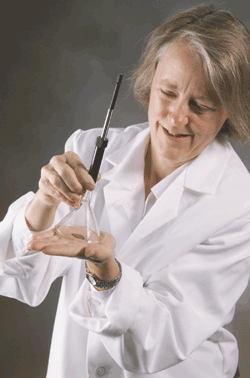The characteristic metallic smell of coins is actually a type of human body odour
The musty smell that most people associate with old pennies and other objects made of iron, copper, or brass is really a human body odour, not a metal vapour, report German and American researchers.
They reached the conclusion after treating the skin of seven volunteers with a ferrous solution, or with iron powder, steel, and cast iron plates. All the volunteers recognised the characteristic metallic smell of iron on their skin. The researchers then collected any volatile odour compounds coming from the skin by placing a glass funnel containing an extraction fiber over the treated area.
Analysis of the samples by gas chromatography revealed a bouquet of carbonyl compounds; the most abundant odorant was identified as 1-octen-3-one.
’It is not every project that can answer an everyday riddle like why do metals smell,’ said Andrea Dietrich, an environmental chemist and part of the team at Virginia Tech, Blacksburg, US. ’The surprise is that the odor was associated with organic molecules and not inorganic metals,’ she told Chemistry World.

These metallic-smelling organic compounds emanate when sweat from human skin corrodes iron metal. This generates reactive ferrous ions that break down lipid peroxides in the skin to create odorous aldehydes and ketones.
’The smell of iron is only an illusion,’ explained Dietmar Glindemann, a chemist at Virginia Tech and leader of the research team. ’What we really smell is a human body odor.’
Similar mechanisms underlie the formation of the metallic odors associated with copper and brass, report Glindemann and colleagues in a recent issue of Angewandte Chemie International Edition.
The researchers were originally trying to find out why consumers sometimes complain about the metallic taste of drinking water. This study suggests that it may not be the water itself that smells, suggests Glindemann. Instead, ferrous ions transported on the skin from metal utensils can react with other chemicals on the skin to release metallic odors.
The team is now using their experience to develop iron-based diagnostic skin tests. People emit specific chemical fingerprints that can change when the body becomes distressed, such as when a person becomes sick. The volatiles that define these chemical fingerprints are often difficult to detect, but applying iron to the skin accelerates the decomposition of peroxides and improves the detection of volatiles.
’Since different sicknesses produce different amounts of peroxides, applying iron to the skin will produce different quantities of odorants,’ explained Glindemann. ’Iron skin tests to detect diseases would be a great achievement.’
Jessica Ebert
6 September 2005: Historic works of art are their own worst enemy
The inks favoured by manuscript writers and old masters for centuries have been destroying the works of art they created, claim Slovenian researchers.
References
Glindemann, D. et al. Angew. Chem. Int. Ed., 2006, 45, 7006






No comments yet